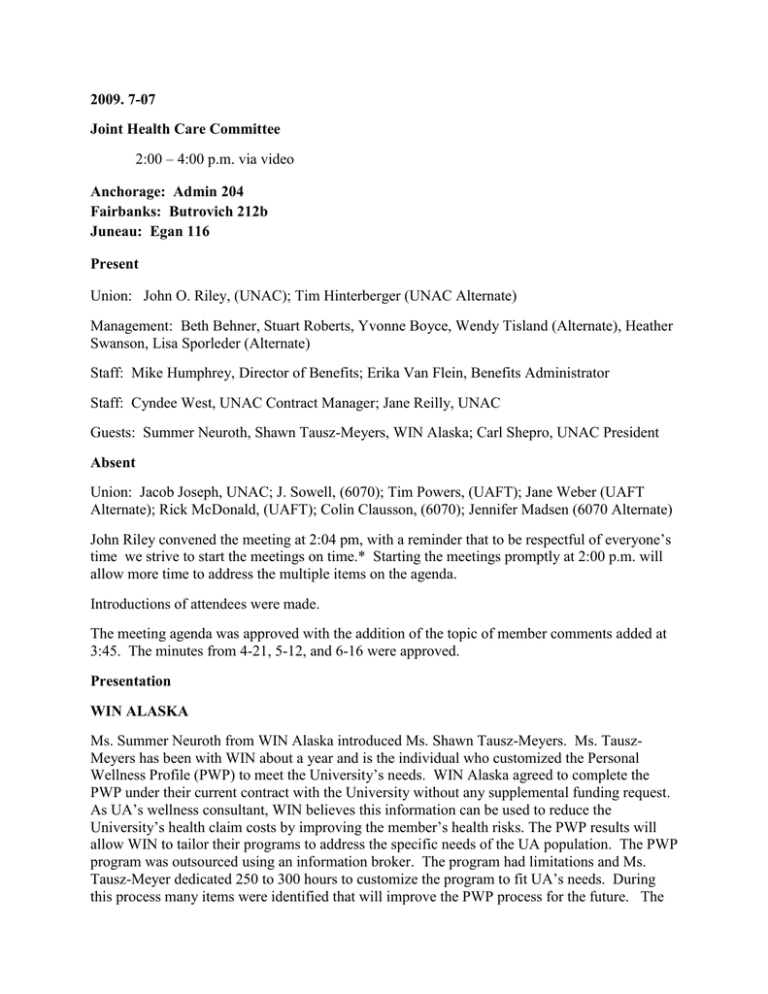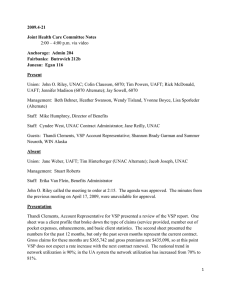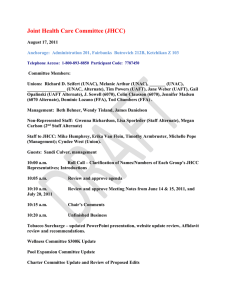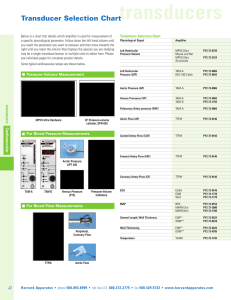7/7/09 Minutes
advertisement

2009. 7-07 Joint Health Care Committee 2:00 – 4:00 p.m. via video Anchorage: Admin 204 Fairbanks: Butrovich 212b Juneau: Egan 116 Present Union: John O. Riley, (UNAC); Tim Hinterberger (UNAC Alternate) Management: Beth Behner, Stuart Roberts, Yvonne Boyce, Wendy Tisland (Alternate), Heather Swanson, Lisa Sporleder (Alternate) Staff: Mike Humphrey, Director of Benefits; Erika Van Flein, Benefits Administrator Staff: Cyndee West, UNAC Contract Manager; Jane Reilly, UNAC Guests: Summer Neuroth, Shawn Tausz-Meyers, WIN Alaska; Carl Shepro, UNAC President Absent Union: Jacob Joseph, UNAC; J. Sowell, (6070); Tim Powers, (UAFT); Jane Weber (UAFT Alternate); Rick McDonald, (UAFT); Colin Clausson, (6070); Jennifer Madsen (6070 Alternate) John Riley convened the meeting at 2:04 pm, with a reminder that to be respectful of everyone’s time we strive to start the meetings on time.* Starting the meetings promptly at 2:00 p.m. will allow more time to address the multiple items on the agenda. Introductions of attendees were made. The meeting agenda was approved with the addition of the topic of member comments added at 3:45. The minutes from 4-21, 5-12, and 6-16 were approved. Presentation WIN ALASKA Ms. Summer Neuroth from WIN Alaska introduced Ms. Shawn Tausz-Meyers. Ms. TauszMeyers has been with WIN about a year and is the individual who customized the Personal Wellness Profile (PWP) to meet the University’s needs. WIN Alaska agreed to complete the PWP under their current contract with the University without any supplemental funding request. As UA’s wellness consultant, WIN believes this information can be used to reduce the University’s health claim costs by improving the member’s health risks. The PWP results will allow WIN to tailor their programs to address the specific needs of the UA population. The PWP program was outsourced using an information broker. The program had limitations and Ms. Tausz-Meyer dedicated 250 to 300 hours to customize the program to fit UA’s needs. During this process many items were identified that will improve the PWP process for the future. The Executive Summary Report gave results of the PWP including number of participants (demographics and health interests), particular health risks of the population such as coronary disease, cancer, diabetes and osteoporosis; participant’s status in various areas from nutrition, weight and fitness to chronic health conditions. There appeared to be a large discrepancy between the number of participants who reported elevated cholesterol and blood pressure while completing the PWP and the number of participants with these conditions as revealed through WIN’s on site biometric screenings. The latter’s numbers were much higher. There was some discussion on the reason for this disparity. Ms. Neuroth feels the overall risks of the PWP participants are higher than reported, which could be due to participants not wanting to state the true condition of their health. Dr. Shepro asked about the reliability of the screening tests as his results varied greatly between the WIN measurement and his physician’s. WIN is unaware of any problems with the accuracy of their tests, but will look into this possibility. The demographics of the participants were similar to the University’s with some exception. The percentage of participants was 39%, although this did not take into account the number of possible respondents who have dual coverage, i.e. UA employees married to one another are potential PWP participants both as employees and as spouses of employees. Mr. Humphrey said the prior three years’ respondent percentages were between 46% and 49%. WIN also presented a graphed presentation of the PWP data. Their final report proposed potential health savings to UA in health claims, productivity and absenteeism with various levels of risk reduction. If wellness practices reduce risk by 20%, savings based on current average claim cost savings would be approximately $3,420,320. Ms. Neuroth closed with the recommendation that the PWPs be performed every other year instead of yearly and said that WIN looks forward to helping the UA improve its members’ health in the future. DEPENDENT AUDIT Mr. Humphrey reminded the committee that the administration must have clear guidelines on the issues that are being proposed for changes for the next year by December. The committee has five meetings left in which to consider their recommendations for changes. He continued with a discussion of the issues before the committee, starting with positive dependent enrollment (dependent audit). Proposed savings of 3% would not be realized as the University is self-insured so an audit may not be worth the cost of hiring a consultant to administer one. In addition, the perceived invasiveness of an audit may create workforce alienation. Ms. Behner suggested a less intrusive way of enforcing positive enrollment, perhaps asking for a signed confirmation of eligible employees to be returned each year during open enrollment. Ms. West suggested a form could be sent with contract renewals each year. Ms. Van Flein talked about using worksite Personnel Payroll Assistants (PPAs) to contact each employee and verify that the dependent information on file is true and correct. Dr. Riley suggested a subcommittee meet to look at alternative verification methods and report back to the committee at the August meeting. A subcommittee composed of Ms. Tisland, Mr. Roberts and Ms. Van Flein will research and review alternate approaches for verifying dependents listed by UA employees, including finding out how other institutions handle this issue. They will report back to the JHCC and make recommendations for the committee’s consideration. VSP Mr. Humphrey asked whether anyone wanted to have further discussion regarding the presentation of information VSP provided in April. It was determined that a report with the past year’s (7/01/08-6/30/09) claim information be acquired. This information will be compiled for a discussion of VSP at the October meeting. It was again stressed that any changes to the plan must be finalized by December. DISEASE MANAGEMENT Mr. Humphrey stated that he feels a Disease Management (DM) program is important to the goals of the overall health benefit plan of UA. In November ’08, BCBS reported a 1.2:1 return on investment (ROI). He reviewed the two plans (BCBS and Accordant) that the committee is comparing and noted that the choice should be based on benefit to the employees, not only cost. The current DM plan through BCBS is triggered by physician claims while Accordant’s plan is triggered by prescription claims, which should result in more timely intercession. Accordant also expressed a willingness to work with our wellness provider to coordinate risk-modifying activities. Questions to be presented to Accordant to clarify areas of concern included: 1) would a 24 hour nurse be available with Accordant as one is with BCBS?, and 2) the actual cost of the Accordant program which they indicated would be subject to UA’s past year’s claim history. At their presentation in June, they did provide “opt-out costs” and the charges for “bundled rare conditions” coverage. Mr. Humphrey noted that the current BCBS DM plan no longer includes the broader disease package, as claims statistics did not support the additional cost. PHARMACY Mr. Humphrey reviewed the cost-containment options given by CVS/Caremark in their May presentation. These included “dispense as written,” maintenance drugs as mail-order only, “stepedit” drug introduction, increased spread between generic and name and non-preferred drugs, and specialty guideline management. Because of the limited amount of time remaining in this meeting, the discussion of changes to the CVS/Caremark plan was deferred until the September meeting. For the September meeting Ms. West requested information on the current plan and what pharmacy savings resulted from the changes that were implemented last year. As these changes included increased co-pays for employees, the committee should look at the impact of these changes before implementing more restrictions that shift costs or fail to have a positive impact. Ms. West further stated that there has been a lack of communication to members as to how they can help in cost containment. ACTION ITEMS The items requiring action were listed. Ms. West would send the information on the FMCS grant out to the committee members. The email system will be used for input on the FMCS interest as the date for submission is August 15th. The subcommittee consisting of Ms Tisland, Mr. Roberts and Ms. Van Flein will bring suggestions about dependent verification for consideration at the August meeting. At the August meeting, Fall River Consulting will give a presentation on auditing our wellness program. At the August meeting, Tim Powers will be asked to present the insurance card idea to the committee. Meeting adjourned at 4:07 P.M. The next meeting of the committee will be held August 18th via video from 2:00 – 4:00 pm. * In order to facilitate the prompt 2:00 p.m. start time, scheduling the video services to be ready at 1:55 p.m. will help to prevent delays due to technology problems.


